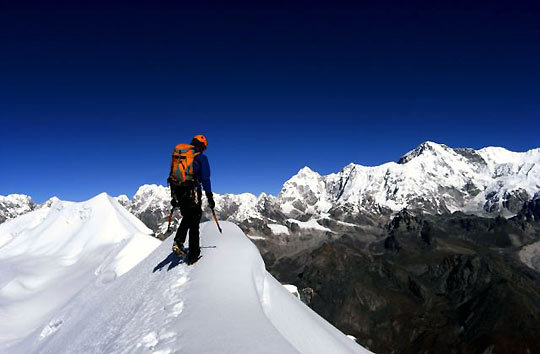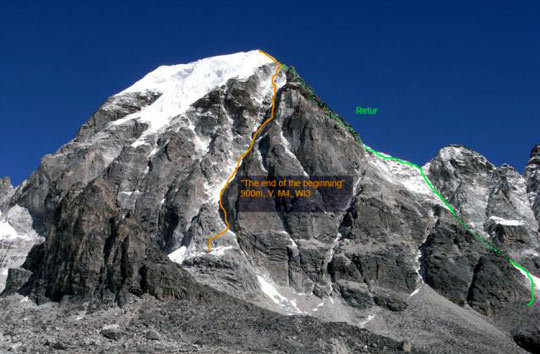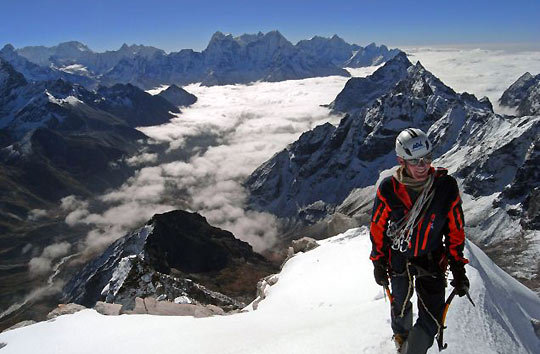
Nils Nielsen, close to the summit of Pharilapcha with the south face of Cho Oyu in the background. [Photo] Halvor Dannevig
In October of this year, Halvor Dannevig and I traveled to Nepal and the upper Khumbu in hope of finding interesting climbing on “not too high” peaks. For us, who consider “how you do it” more important than what peak you actually climb, snow plodding up fixed ropes on famous peaks is not interesting. And for me, a Himalayan rookie, the peaks around Gokyo seamed like a perfect start to my Himalayan climbing. Our main objective was an unclimbed line on the north face of Phari Lapcha (aka Machermo, 6017m). Staying at the Gokyo Resort Lodge, we had a perfect view across the lake to the north face. The more we looked through binoculars, the more we realized that it was not ice, but snow that was plastered to the face.
For acclimatization we tried to climb a new line on an unnamed peak (5906m) between Dawa Peak (5920m) and the Renja Pass. Standing in a cave underneath a thin ice curtain, after climbing 200 meters of powder snow and really bad ice, we were not very optimistic. I continued, and for half an hour I climbed 15 meters of snow-covered M5. With no protection in sight and no ice, I abseiled off and found myself 2 meters outside the cave.
The only place we saw ice on the north side of the Phari Lapcha massif was on Snotty’s Gully (M5+ WI5, ca. 1000m), a line climbed by the two accomplished British alpinists Nick Bullock and Jon Bracey last year. With so many unclimbed lines around, it didn’t feel right when we walked the approach to the base of the climb, but we had traveled to Nepal to find nice climbing, so it didn’t really matter that much. We started climbing at 5 a.m. the next day, carrying chocolate in our pockets and one small pack with just water and two down jackets. Being from Norway, we like to think that we have the best ice climbing in the world. But when we stood on the summit at 2:40 p.m. the same day, we realized that some of the pitches of perfect water-ice would have been super-classics in any valley in our home country. We abseiled and downclimbed to the Machermo Glacier and hoped to have a look at the south side of Phari Lapcha to see if there were any interesting lines there. Because of afternoon clouds, we never saw this side of the mountain, but stumbling into the village of Machermo at 6:30 p.m., happy for dinner and a warm bed, we decided to try something else up there after a couple of rest days.

The southwest face of Phari Lapcha (6017m) with the route The End of the Beginning (M4 WI3 ca. 900m) and the southeast-ridge descent. The picture is taken from the Machermo valley at about 5000m [Photo] Nils Nielsen
Pitching a tent at 5250m, close to the Machermo Glacier, we saw a gully of snow, ice and rock on the southwest side of Phari Lapcha. Starting at 3 a.m. the next day, we climbed 100 meters of rock to get into the gully. Three-hundred meters higher, after climbing snow and perfect ice up to WI3, we found our self at the crux–two long pitches of verglassed rock. It was not too difficult to climb (M4) but very interesting to protect. After three more mixed pitches, we were in the upper part of the gully, safe from rockfall and on easier ground. Two-hundred meters higher, after climbing steep snow with short sections of rock, we joined the southeast ridge. At 9 a.m. we stood on the summit of Phari Lapcha, after climbing a route we believe was a first ascent. The End of the Beginning (M4 WI3, ca. 900m) was climbed in the same light style as the second ascent of Snotty’s Gully, with just one small pack and in six hours. Both of us found the route very similar to the Eugster Direct on the north side of Aiguille du Midi in the French Alps.
Even though, we didn’t climb what we came for; our main goal was attained–to have fun and do some good climbing. And going home, in hope of a winter with good skiing and even better climbing, we were already talking about other things to do in the beautiful country of Nepal.
Editor’s Note: The upper Khumbu region has seen significant activity in recent years, with some confusion as to what peaks have been named, or mis-named. Phari Lapcha West, the peak climbed by Bullock and Bracey in October of 2006 (and now Nielsen and Danneivig), also has been referred to as Dawa Peak. Pharilapcha, the 6017-meter central peak of the massif, also has been referred to as Machermo, which is also the name for the glacier below it. Some explanation of the confusion can be read in this January 4, 2007 NewsWire.

Halvor Dannevig high on the south-east ridge during the ascent of The End of the Beginning, with Thamserku and Kang Taiga in the background. [Photo] Nils Nielsen